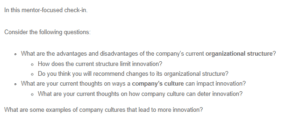Enhancing Innovation in a Tall Matrixed Organizational Structure
The Advantages and Disadvantages of the Company’s Current Organizational Structure
-
- How does the current structure limit innovation?
The company’s current structure is a tall matrixed structure. Consequently, the structure limits innovation by limiting the exchange of ideas because communication is slow and difficult. In addition, the structure limits innovation because decision-makers are far from the customer and do not understand customer needs. The centralization of resources also makes it hard for employees to try out new ideas, thus limiting innovation.
-
- Do you think you will recommend changes to its organizational structure?
I will recommend changes to the organizational structure to create an innovation culture. One of the changes I recommend is involving employees in decision-making to propose their innovative ideas and get support from top management to implement them. I will also recommend creating flexible processes to allow employees to work on their creative ideas. My other recommendation would be decentralizing resources so that they can be easily accessible to employees in all the departments.
My Opinion on The Way a Company’s Culture Can Impact Innovation
Company culture plays a vital role in shaping the mindset and behavior of employees, thus promoting or deterring innovation. Company culture can hinder innovation if it creates a work environment where employees are more concerned about their job security and getting promoted because they will only focus on doing what they are told by their seniors and be reluctant to propose new ideas (Weiss & Legrand, 2011). Company culture can also deter innovation if all decisions are made by those at the top of the hierarchy. This may discourage employees from sharing their innovative ideas because they fear that they will be rejected or implemented without their involvement.
-
- What are some examples of company cultures that lead to more innovation?
Certain company cultures have been associated with more innovation. They include connected, progressive, autonomous, and rewarding cultures. Connected company culture includes making employees feel appreciated and valued, thus creating a sense of belonging, which in turn promotes the exchange of ideas. Progressive company culture is characterized by continuous growth and encouraging employees to come up with new ideas to meet the company’s long-term and short-term goals. An autonomous culture encourages independent decision-making, thus enabling employees to try out new ideas. On the other hand, a rewarding culture includes recognizing employees when they exceed the company’s expectations and rewarding them to appreciate them for their efforts.
References
Weiss, D. S., & Legrand, C. (2011). Innovative intelligence: The art and practice of leading sustainable innovation in your organization. John Wiley & Sons.
ORDER A PLAGIARISM-FREE PAPER HERE
We’ll write everything from scratch
Question

Tall Matrixed Organizational Structure
In this mentor-focused check-in.
Consider the following questions:
- What are the advantages and disadvantages of the company’s current organizational structure?
- How does the current structure limit innovation?
- Do you think you will recommend changes to its organizational structure?
- What are your current thoughts on ways a company’s culture can impact innovation?
- What are your current thoughts on how company culture can deter innovation?
What are some examples of company cultures that lead to more innovation?

